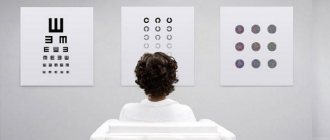Clinical picture
Color vision disorders can be congenital or acquired. Anomalies of color vision, which are acquired in nature, are observed in pathologies of the retina, optic nerve, central nervous system, poisoning, and intoxication. They are manifested by a violation of the perception of the three primary colors and are accompanied by various visual impairments. These disorders usually change their nature during the course of the disease and during its treatment, while congenital disorders cannot be corrected. Typically, congenital disorders depend on the weakening or complete loss of function, usually of one of the components. This vision is called dichromasia. Pathology of color perception can be inherited.
According to the classification of Chris and Nagel, the following types of color vision are distinguished:
- normal trichromasia;
- abnormal trichromasia;
- dichromasia;
- monochromasia;
Anomalous trichromasia is in turn divided into protanomaly, deuteranomaly, and tritanomaly. Dichromasia is divided into protanopia (partial red color blindness), deuteranopia (partial green color blindness), tritanopia (partial blue or violet color blindness).
Color blindness test
To identify color blindness (color blindness) and its manifestations in modern ophthalmology, polychromatic Rabkin tables are used. According to the degree of color perception, ophthalmologists distinguish: trichromantics (normal), protoanopes (people with impaired color perception in the red spectrum) and deuteranopes (people with impaired color perception in the green spectrum).
To pass the test for color blindness , you should follow certain recommendations:
- The test is carried out when you feel normal
- first you need to relax
- try to keep the picture and eyes at the same level while taking the test
- You have up to 10 seconds to view the picture.
Picture 1
The picture shows the numbers “9” and “6”, which are visible to both people with normal vision and people with color blindness. The picture is intended to explain and show people what exactly needs to be done when taking the test.
Figure 2
This picture shows a square and a triangle, which, as in the previous version, are visible to both people with normal vision and people with color blindness. The picture is used to demonstrate the test and to identify malingering.
Figure 3
The picture shows the number “9”. People with normal vision see correctly, while people with blindness in the red or green part of the spectrum (deuteranopia and protanopia) see the number “5”.
Figure 4
The picture shows a triangle. People with normal vision see the triangle shown, while people with red or green blindness see a circle.
Figure 5
The picture shows the numbers “1” and “3” (the answer is “13”). People with blindness in the red or green part of the spectrum see the number “6”.
Figure 6
People with normal color perception distinguish two geometric shapes in the picture - a triangle and a circle, while people with blindness in the red or green part of the spectrum are not able to distinguish the figures depicted in the picture.
Figure 7
The picture shows the number “9”, which can be distinguished by both people with normal color perception and people with color blindness.
Figure 8
The picture shows the number “5”, which can be distinguished by people with normal vision and people with blindness in the red or green part of the spectrum. However, for the latter, this is difficult or even becomes impossible.
Figure 9
People with normal color vision and people with green color blindness can see the number “9” in a picture, while people with red color blindness can see both the number “9” and “8” or “6.”
Figure 10
People with normal vision distinguish the numbers “1”, “3” and “6” in the picture (they answer “136”), while people with blindness in the red or green part of the spectrum see “69”, “68” or “66”.
Figure 11
The picture shows the numbers “1” and “4”, which are seen both by people with normal color vision and by people with manifestations of color blindness.
Figure 12
The picture shows the numbers “1” and “2”, which both people with normal vision and people with blindness in the green part of the spectrum can distinguish, while people with blindness in the red part of the spectrum cannot see the numbers at all.
Figure 13
The picture shows a circle and a triangle that people with normal color vision can distinguish. At the same time, people with blindness in the red part of the spectrum see only a circle in the picture, while people with blindness in the green part of the spectrum only see a triangle.
Figure 14
People with normal color perception in the picture will distinguish the numbers “3” and “0” in the upper part, but will not see anything in the lower part. Whereas people with blindness in the red part of the spectrum will distinguish the numbers “1” and “0” in the upper part, and the hidden number “6” in the lower part. And people with blindness in the green part of the spectrum will see “1” at the top, and “6” at the bottom of the picture.
Figure 15
People with normal color perception will distinguish a circle and a triangle in the picture (in the upper part), but will not see anything in the lower part. People with red blindness will see 2 triangles (top) and a square (bottom). People with green blindness will differentiate between a triangle (top) and a square (bottom).
Figure 16
People with normal color vision will distinguish between the numbers “9” and “6” in the picture, while people with red blindness will only see “9”, and people with green blindness will only see “6”.
Figure 17
People with normal color vision see a circle and a triangle in the picture, while people with red-blindness see only a triangle, while people with green-blindness see only a circle.
Figure 18
People with normal color perception will see multi-colored vertical and single-color horizontal rows in the picture. In this case, people with blindness in the red part of the spectrum will see the horizontal rows as single-color, and the vertical rows 3, 5 and 7 as single-color. People with green blindness will see the horizontal rows as multi-colored and the vertical rows 1, 2, 4, 6, and 8 as single-color.
Figure 19
People with normal vision are able to distinguish the numbers “2” and “5” in a picture, while people with blindness in the red or green part of the spectrum will only see the number “5”.
Figure 20
People with normal color vision are able to distinguish two geometric shapes in a picture - a triangle and a circle, while people with blindness in the red or green part of the spectrum will not be able to distinguish between the depicted figures.
Figure 21
In the picture, people with normal color vision and people with red color blindness will distinguish between the numbers “9” and “6,” while people with green color blindness will only see the number “6.”
Figure 22
The picture shows the number “5”, which can be distinguished by both people with normal color perception and people with manifestations of color blindness. However, for the latter it will be difficult or even impossible to do this.
Figure 23
In the picture, people with normal vision will see multi-colored horizontal and single-color vertical rows. At the same time, people with blindness in the red or green part of the spectrum see single-color horizontal and multi-colored vertical rows.
Figure 24
In the picture, the number “2” is exactly what people with normal vision see; protanopes and deuteranopes do not distinguish this number.
Figure 25
Trichomats (people with normal vision) see the number “2” in the picture, people with blindness in the green and red parts of the spectrum do not distinguish the number “2”.
Figure 26
People with normal color perception distinguish two shapes in the picture: a triangle and a square. People with green and red spectrum blindness cannot distinguish between these figures.
Figure 27
Normal trichomats see a triangle in the picture, people with color vision impairments distinguish a “circle” figure
It should be noted that if you answer incorrectly, there is no need to start panicking, since perception may depend on a number of factors: room lighting, excitement, monitor matrix and its color (when taking the test online), etc.
If abnormalities are detected during a free online vision test, it is recommended to see a specialist for a more thorough diagnosis.
There is good news for people with color vision impairment - glasses for colorblind people have been developed. All details can be read in this article.
Incidence (per 100,000 people)
| Men | Women | |||||||||||||
| Age, years | 0-1 | 1-3 | 3-14 | 14-25 | 25-40 | 40-60 | 60 + | 0-1 | 1-3 | 3-14 | 14-25 | 25-40 | 40-60 | 60 + |
| Number of sick people | 7 | 7 | 7 | 7 | 7 | 7 | 7 | 2 | 2 | 2 | 2 | 2 | 2 | 2 |
Forecast and prevention of color vision anomalies
Prevention of the development of color vision anomalies has not been developed. All patients with color blindness, achromatopsia and acquired color vision deficiency should be registered with an ophthalmologist. It is recommended to undergo examination 2 times a year with additional ophthalmoscopy, visometry and perimetry. You should take multivitamin complexes containing vitamins A and E, and adjust your diet with the obligatory inclusion of foods rich in vitamins and microelements. The prognosis for life and work ability with color vision anomalies is favorable. In this case, patients often experience a decrease in visual acuity, and it is impossible to restore normal color perception.
LiveJournal
Symptoms
| Occurrence (how often a symptom occurs in a given disease) | |
| Color perception disorder | 100% |
| Poor vision at dusk | 90% |
| Rapid eye fatigue when performing visual work (eye fatigue, visual fatigue, eye strain, asthenopia) | 80% |
| Decreased visual acuity (deterioration of vision, poor vision) | 80% |
| Intolerance to bright light (photophobia, light sensitivity) | 60% |
| Double vision (diplopia) | 50% |
Mechanism of anomaly
Cones, special nerve cells located in the center of the retina, are responsible for distinguishing colors in the eye apparatus. In healthy people, cones contain three pigments “responsible” for recognizing red, green and blue colors. The combination of these basic colors in the cerebral cortex gives us the wide palette of shades that we enjoy every day. In some cases, the pigment may either be absent altogether or not work properly. It is then that the peculiarities of color perception arise. The disruption of which photoreceptors led to the development of color blindness can be determined by the doctor.
Causes and mechanism of inheritance of color blindness
Genetically determined color blindness
The most common form of color vision impairment. The hereditary mechanism of color blindness is associated with the X chromosome. Other hereditary diseases associated with X-recessive inheritance are transmitted according to the same scheme: hemophilia, hereditary ichthyosis, Wiskott-Aldrich syndrome.
If the father suffers from color blindness, and the mother is not a carrier of the color blindness gene defect, then all the sons of this couple will be healthy, and all daughters will be carriers of the defective gene.
If the father is color blind and the mother is a carrier, the sons have a 50% chance of being affected, half of the daughters will be carriers, and the other half of the daughters will be color blind.
The likelihood of the latter option increases in closely related marriages, when relatives have color vision impairments.
Acquired color blindness
A rare form of the disease associated with eye disease or injury that affects the retina or optic nerve.
What is color perception
The human brain is capable of distinguishing a lot of different shades. The retina of the eye, or more precisely, the cone cells, is responsible for this ability. In a healthy person, color is perceived by three devices that are sensitive to waves of different lengths and radiation. If the eye does not distinguish one color from another, this indicates a violation of color perception.
The pathology can be acquired (in diseases affecting the area of the optic nerve or retina) or congenital. In this case, the disorder is called color blindness. If such a diagnosis is made, a driver's license will not be issued.
Color vision impairment and driver's license
People first started talking about color blindness and driving at the end of the 19th century. In 1975, a major railway accident occurred in Sweden. The culprit turned out to be a driver who could not recognize the red color of the traffic light. After this incident, drivers and railway workers began to be additionally checked not only for the quality of vision.
Many car owners are interested in the question: is it necessary to replace a driver’s license if color vision is impaired?
In Russia, until 2012, people with mild color blindness were allowed to drive a car (category B and C), using it for personal purposes. In 2021 the rules have changed. According to the legislation of the Russian Federation, colorblind people are no longer allowed to drive a car. Such a driver poses a serious danger to other road users and pedestrians.
If it's time to replace your license, a color vision test can't be avoided. In 2021, the chances of colorblind people getting a driver's license are minimal. In developed countries, those who constantly wear colored contact lenses or glasses are allowed to drive a vehicle. With their help, the world of a colorblind person becomes colorful, that is, the way an ordinary person sees it.
Conclusion
Persons with color vision disorders lead a completely normal life, with the exception of some discomfort. Colorblind people are somewhat limited in their choice of profession; they cannot become soldiers. Also, since 2017, car owners suffering from color blindness have virtually no chance of obtaining a driver’s license.
Rabkin tables
Color vision impairments are allowed when obtaining a driver's license, but only to a minor extent. The most common in Russia are Rabkin tests, which consist of 48 tables. They are divided into two groups: main (27 tables) and control, which are used if questions arise and the need to detail visual function.
Rules for testing using Rabkin tests:
- The monitor screen on which each picture is displayed should not be too bright or dim.
- All tables should be at eye level. Positioning higher or lower may affect the accuracy of testing.
- There is a time limit - 5 seconds per picture.
As a rule, to check whether a person has color blindness, it is enough to take a test using the first 27 pictures. The specialist indicates the diagnosis, as well as the degree of the anomaly (weak, moderate or strong).
Is it possible not to take the test using Rabkin's tables?
Great yogis or mahatmas said about color vision impairment that these are special people. Unfortunately, such car owners cannot successfully pass the test for the ability to distinguish colors. Theoretically, you can learn all the pictures by heart. But the doctor may show them out of order, which significantly reduces the chances of success.
Some people believe that you can always negotiate with an ophthalmologist. But in this case it is worth assessing whether such a risk is really justified. After all, not only other road users, but also the driver himself may be at risk. If you can't see how the colors change at a traffic light, you shouldn't drive.










